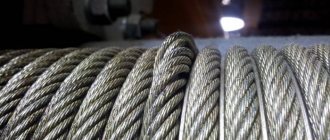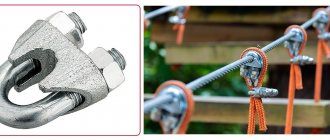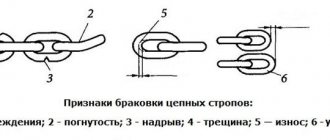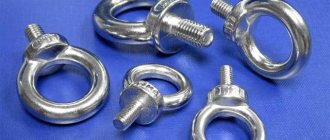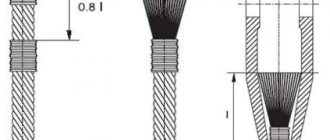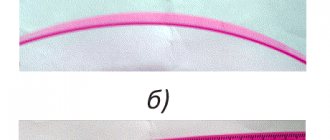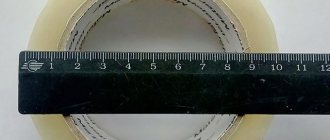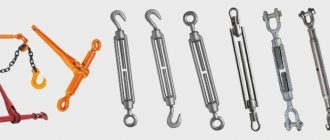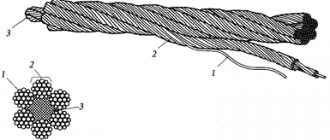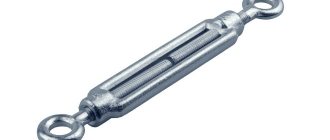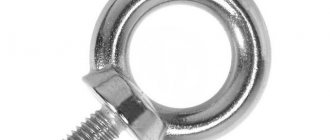Lifting work is classified as potentially dangerous, therefore all equipment used during this work is subject to special requirements in terms of their suitability for use. The condition of all components of lifting equipment is important not only for the safety of cargo, but, first of all, for the safety of the personnel carrying out the work.
The rules and regulations for the operation of such equipment, including the rejection of slings, are established by regulations and PB 10-382-00
,
POT RM-007-98
, etc. For each type of sling, the requirements for safe operation are determined by the relevant sections of
RD 24-SZK-01-01
,
RD 10-33-93
and
RD 11-07-2007
, which determine the timing and composition of control and rejection of lifting slings.
Timing and procedure for inspection and rejection of slings
In accordance with the requirements of regulatory documents, the owner, when using slings regularly, must inspect them every 10 days. Slings that are rarely used should be inspected before each use. Loop and ring slings must be inspected each time they are put into use.
Inspection and rejection of slings must be carried out by a representative of the engineering and technical
responsible for the serviceability of this equipment and the safety of the work performed.
During these activities, external and internal inspection is carried out, as well as instrumental control, on the basis of which a conclusion is made about the compliance of the slings with the characteristics given in the product passport
.
The results of the inspection are recorded in the inspection log
. If damage or defects are identified, the log should contain information about their elimination. The journal must be filled out in accordance with the established form, which indicates:
- symbol and name of the sling;
- serial number of the product;
- product passport number and manufacturer's name;
- where, when, to whom the sling is directed;
- date of last survey;
- conclusion on the possibility of using the sling;
- The results must be certified by the signature of the responsible person.
When inspecting slings, you should check the condition of chains, tapes, ropes, end elements, carabiners, pendants, and their attachment points.
Exploitation
3.1. The specialist responsible for maintaining lifting structures in working condition is obliged to ensure that removable lifting devices and production containers are maintained in good condition (if their maintenance in good condition is not entrusted to other persons by order) by conducting periodic inspections, maintenance and repairs within the time limits established by the schedule, systematic monitoring of the correct maintenance of the inspection log and timely elimination of identified faults, as well as personal inspection of lifting devices and containers within the established time frame.
3.2. The specialist responsible for the safe performance of work using lifting structures is obliged not to allow untested, unmarked or damaged removable lifting devices and containers into work, and to provide slingers with distinctive signs.
3.3. Personnel assigned to carry out cargo hooking work, incl. in hanging lifting structures on hooks, slinging and tying loads moved by lifting structures using load-handling devices, must have a level of qualifications corresponding to the profession of slinger.
The same requirement applies to personnel of the main working professions, whose duties include hanging cargo on a hook without preliminary strapping (load that has loops, eyes, pins, located in buckets, tubs, containers or other containers), as well as in cases when the load is grabbed by semi-automatic gripping devices.
3.4. For lifting structures controlled from the floor, hooking a load onto a hook without preliminary strapping is permitted to be performed by personnel of basic working professions who have undergone testing of their skills in hooking loads and training at the workplace.
3.5. A graphic representation of slinging and hooking methods should be handed out to slingers and crane operators or posted at work sites.
3.6. Faulty load-handling devices, as well as devices that do not have tags (stamps), should not be located in the work areas. Unmarked and damaged containers are not allowed in the work areas.
3.7. Loads must be slinged in accordance with slinging diagrams. To sling a load intended for lifting, slings must be used that correspond to the weight and nature of the load being lifted, taking into account the number of branches and their angle of inclination; General purpose slings should be selected so that the angle between their branches does not exceed 90°.
3.8. The connections between the hook of the lifting machine and the suspensions, loops and thimbles of the slings must be reliable. The sling suspension must be secured with a hook latch. The mounting loop must be secured with a latch in the hook link of the sling.
3.9. In order to prevent loads from falling during lifting and moving them by lifting structures, the following slinging rules should be observed:
when tying the load, the slings must be applied without knots or twists;
Under sharp corners of metal weights (channels, angles, I-beams) it is necessary to place pads. In this case, it is necessary to take into account the location of the center of gravity of the load. The sling should be placed under the load in such a way as to prevent it from slipping while lifting the load. The load must be tied in such a way that during its movement, the fall of its individual parts is prevented and a stable position of the load is ensured during movement. To do this, slinging of long loads (poles, logs, pipes) must be done in at least two places;
The ends of the multi-leg sling that are not used for hooking must be strengthened so that when moving the load by crane, the possibility of these ends touching objects encountered along the way is excluded.
3.10. When moving a load, load-handling device or container horizontally, it should first be lifted 500 mm above equipment, building structures and other objects encountered along the way.
3.11. It is allowed to lower the transported load only to the place intended for this purpose, where the possibility of falling, tipping over or sliding of the installed load is excluded. At the place where the load is installed, pads of appropriate strength must first be laid so that the slings can be easily and without damage removed from under the load.
3.12. When carrying out work with the use of PS, lifting a load covered with earth or frozen to the ground, laid down by other loads, as well as releasing pinched slings, ropes, chains using a lifting machine is not allowed.
Checking textile slings
Checking the suitability of textile slings consists of visual inspection
, during which the markings comply with the passport, the serviceability of loops and seams, connecting elements, and grips is checked.
After this, instrumental control
. Slings are not allowed for use if the following defects are detected:
- lack of markings or tags;
- the presence of knots or transverse breaks on the load-bearing tapes of the slings, regardless of their size;
- longitudinal cuts or tears exceeding 50 mm, and their total length is more than 10% of the length of the sling branch;
- local delamination of the tapes, except for the places where their edges are sealed, exceeds 0.5 m and has a gap of three or more lines on one extreme or two internal seams;
- local delamination on the sealing of the edges exceeds 0.2 m on one extreme or two internal seams, as well as peeling of the edge or stitching of the tapes at the loop, the length of which exceeds 10% of the length of the sealing of their ends;
- surface breaks of the belt threads resulting from the mechanical impact of the load, exceeding 10% of the belt width;
- damage from chemicals (alkalies, acids, solvents, petroleum products, etc.) exceeding 10% of the total length and width of the sling;
- bulging of threads or through holes from sharp objects or burns, the diameter of which exceeds 10% of the width of the tape;
- contamination with soil, cement, paints, petroleum products, etc., exceeding 50% of the sling length.
All of the above applies to textile tape slings. Rejection standards for round-strand slings also include: rupture of the cover, breakage of more than 6 wires, breaks of threads in stitching nodes exceeding 10% of its length, holes in the cover.
Repair
5.1. Restoration repairs involving welding of load-handling devices, containers and their elements must be carried out in specialized organizations that have technical means and qualified specialists.
5.2. Routine repair of elements of lifting devices and containers without the use of welding (straightening parts, sealing ends of ropes, replacing fasteners, etc.) must be performed by mechanics for the repair and maintenance of hydraulic lifting equipment, in accordance with the repair documentation and under the guidance of a specialist responsible for the maintenance of lifting structures in working condition
5.3. Information about the quality of individual repair work must be entered in the repair log. When accepting a lifting device or container from repair, it is necessary to inspect and test it in order to determine the degree of reliability.
Rope sling inspection
Rope slings produced in accordance with GOST
25573-82
and
RD-10-33-93
must be subject to three stages of inspection: external and internal inspection and instrumental control. Rope slings with identified deficiencies are rejected and not allowed to work.
When inspecting slings, the following are checked:
- compliance of the type of sling and markings on the tag with the passport data of the product;
- serviceability of loops at the end of the rope;
- the presence of defects and damage along the length of the sling and their level;
- condition of the core and internal strands of the rope.
Based on the inspection results, the rope sling is not allowed to work in the following cases:
- absence or damage of a tag or passport for the sling;
- the presence of knots, twists, kinks and creases in the ropes;
- the number of visible breaks of the outer wires for a double lay rope exceeds: 3´d - 4, 6´d - 6, 30´d - 16;
- due to corrosion or wear, the diameter of the rope has decreased by 7% or more;
- due to corrosion or wear, the diameter of the outer wires of the rope has decreased by 40% or more;
- due to damage to the core, the diameter of the rope decreased by 10%;
- core extrusion;
- strand break;
- damage due to electrical arcing or temperature effects;
- deformation of the thimble, cracks in the compression sleeve, lack of safety locks on the gripping elements.
General information
1.1.
Removable load-handling devices and containers are used in the process of lifting and moving goods using lifting structures. Slinging, tying and hooking of solid loads for lifting, moving and lowering them when performing construction, installation, loading and unloading and other work using lifting structures is carried out using removable load-handling devices. Moving small-piece cargo is allowed only in special containers designed for this purpose in order to exclude the possibility of individual parts of the cargo falling out. Bricks are moved on pallets without fencing only when unloading (loading) vehicles onto the ground (and from the ground), unless otherwise specified in the operating manual (instructions) and other operational documents for the container or in the PPR. To lift and move liquid and bulk cargo, special containers are used (tubs, trays, boxes, containers, buckets, etc.).
1.2. Depending on the conditions of work, the geometric dimensions and weight of the load, lifting devices of different designs are used (slings, traverses, grips, etc.). Slings are among the simplest lifting devices in design and are flexible elements with end fastenings and gripping elements of various designs. As a rule, steel wire ropes, less often chains and tapes, are used as a flexible load-bearing element.
1.3. Steel ropes have a high specific load-bearing capacity and flexibility, are much easier to work with and more durable than ropes made from organic plant fibers or steel load chains. A steel wire rope smoothes out dynamic loads and is reliable, since the destruction of the rope does not occur suddenly, like a chain, but the number of broken wires increases gradually, which allows you to monitor the condition of the rope and reject it long before the break.
1.4. The advantages of steel chains compared to steel ropes are their high flexibility, simplicity of design, manufacturability and ability to bend around sharp edges without the use of pads. Significant disadvantages of steel chains are their large mass, the possibility of sudden rupture due to the rapid opening of formed cracks and the need for careful daily monitoring of the condition (wear) of chain links. In addition, steel chains do not allow the application of dynamic loads, and defects in the metal of the chain links are difficult to detect.
1.5. According to the number of branches, slings are divided into single-branch rope (1SC), two-branch (2SC), three-branch (3SC), four-branch (4SC) and universal (USK), single-branch chain (1SC), two-branch (2SC), three-branch (3SC), four-branch ( 4SC) and universal (USC). Simple slings (SK and STs) are used for hanging loads that have special devices (loops, hooks, eyes, bolts, etc.), universal slings are used for slinging loads with a harness. A single-leg sling with a hook or other load-grasping device is usually used to grab and move loads equipped with mounting loops or eyes, brackets, etc.
1.6. Multi-leg slings are used for lifting and moving building parts and structures that have two, three or four attachment points. They are widely used for slinging building elements (panels, blocks, trusses, etc.) equipped with loops or eyes. When using a multi-leg sling, the load must be transferred to all branches evenly, which is ensured by auxiliary connections.
1.7. Universal slings are used when lifting loads that cannot be tied with ordinary slings (pipes, boards, rolled metal, apparatus, etc.).
1.8. Traverses are used for lifting and moving long or large-sized structures or equipment (columns, trusses, beams, apparatus, pipes, etc.). Crossbars are designed to withstand compressive or tensile forces. They protect the load from the compressive forces that occur when the load is tilted and ensure safety when it is moved by a crane. Traverses are hung on the crane hook using a gusset with an eye (ring) or flexible or rigid rods that are hinged, which completely frees them from bending moments. Hanging traverses on a crane hook using rigid and flexible rods leads to loss of useful lifting height. Rope slings at the free end end with hooks of various designs that interact with product staples or pin locks mounted on a traverse with thimbles inserted into the sockets of the lock body. The pin is pulled out manually by the rope attached to it (remote control).
1.9. Grips are the most advanced and safe load-handling devices, the main advantage of which is the reduction of manual labor costs when grabbing a load and placing it in the designed position by a crane. It is advisable to use grippers in cases where it is necessary to move structures of the same type. With grips installed on the slings, you can quickly secure the sling to the rails, channels and beams being lifted. Using connecting links and rigging shackles, the grippers are quickly secured to the slings. The slings can also be used to attach hooks, sheet clamps, and other accessories.
1.10. The most common types of steel technological containers for lifting and moving piece, packaged, semi-liquid and liquid cargo, as well as cargo classified as explosive and fire hazardous, are boxes, tubs, containers, bunkers, containers, pallets and other packaging devices.
Textile slings
Both lanyards and rope slings add foldables for maneuvering and importance. The stench is not suitable for robots with loud or far-fetched vantages, because they can damage the surface. In this situation, textile slings will come in handy as they provide the necessary flexibility, reliable fixation and necessary slinging.
Textile slings come in two types – stitch or round-strand. The first ones are produced in seemingly stitches from one or several balls of synthetic material (nylon, polyester or propylene). Round strand slings are made from a polyester core placed in a sleeve made of polyester or nylon fabric. For plasticity and flexibility, round-strand models are superior to stitch ones.
The design of the sling is divided into three types:
- loops (STP) – a stitch with two loops at the ends, covered with tread fabric;
- kіltsevі (STK) – a stitch, closed in a ring;
- Gilkov - can be with one (1ST), two (2ST), three (3ST) or several (4ST) sleeves equipped with vantage-spitting elements.
The designation of orbicular virobes is preceded by the letter “K”. Ring and loop options are the most universal. They are used for tying the vantages.
The slings are made in different colors. The color of the stitch means its importance. Color identification is used for clear visual distinction between colors. The width of the stitch also depends on the flexibility of the stitching.
The main advantage of textile slings is their compactness and low weight. When stored properly, they take up minimal space and are easy to transport. The top stitching does not damage the fabric. Synthetic materials, made from chemically resistant materials, are resistant to temperature changes, moisture, infusion of naphtha products and organic solvents. Fabricating textile slings is much cheaper than rope and lance slings.
The maximum temperature of the surface of the rods with which the lines are in contact must not exceed 100 degrees, and the minimum cannot be lower than -40 degrees. Textile materials are not resistant to acids or acids. Preserve drying only in closed areas due to resistance to ultraviolet radiation.
How to assess the condition of the cable core (its property)
Service life of workwear: standards
Based on the standards for rejecting steel ropes, they can be considered faulty even in the absence of external damage. This happens if flaw detection reveals damage to the core. The rope is considered unsuitable for use if the inspection reveals more than 18% loss of wires of the internal part.
Note! Not every enterprise has such equipment, as well as specialists to service it. And this is normal, because there is no need to constantly check the sealed parameters of the core. These tests are only required for products that must meet very high safety requirements.
In production
Traverses
Traverses are special removable devices for grasping cargo. It secures goods during loading and unloading and can be used for lifting long loads or where height is limited. Crossbars are manufactured according to drawings, depending on the task they will have to perform. They make mounting traverses, magnetic and lifting.
Lifting beams lift the crane beams and the braking system. The gripper is secured with a pin to the beam under the crane. When the crane beam is installed in the design position, the pin is removed. The crossbars are attached with hooks to a special platform.
Magnetic traverses do not require external energy to hold the load. The magnetic field created by the devices does not interfere with the operation of neighboring mechanisms. The length of the traverse is changed using 2 cylinders. A load length of 12 meters is possible.
